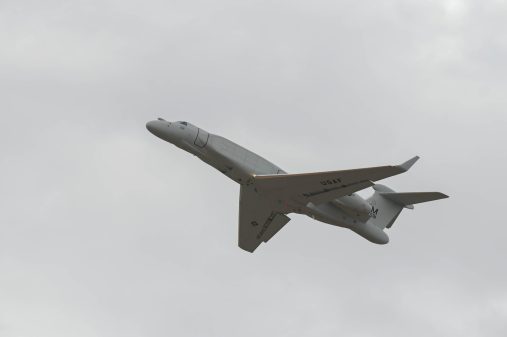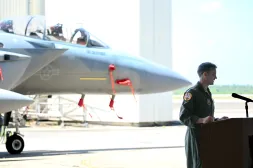F-16 electronic self-protection system reaches milestone, sets up operational test

The only electronic warfare system for F-16 fighter jets just passed a critical milestone, setting up the next stages that will lead to production and fielding decisions.
The Northrop Grumman-made AN/ALQ-257 Integrated Viper Electronic Warfare Suite (IVEWS) successfully passed the Air Force’s Joint Preflight Integration of Munitions and Electronic Sensors test, which involves integrating the system on an F-16 and placing the entire aircraft in an anechoic chamber to test the system along with the other capabilities on the jet.
“What makes the J-PRIMES so key is the fact that we actually had an IVEWS system installed on an F-16 and the whole F-16 went up into J-PRIMES,” James Conroy, vice president of the navigation, targeting and survivability business at Northrop, told DefenseScoop in an interview. “You’re no longer just testing the IVEWS system by itself, but you’re testing it installed on an F-16 so … the other APIs are up and running, we’re running everything and then you’re taking and doing RF threat simulators that are actually stimulating the IVEWS system, making sure that the IVEWS system can detect and ID while it’s installed on a platform.”
IVEWS is a self-protection system and is the only electronic warfare system on the F-16 providing digital radar warning receiver performance and active jamming capability that can detect, identify, locate and counter potential threats.
Self-protection systems have grown in importance in recent years due to the change in the threat environment and the sophistication adversaries are demonstrating within the electromagnetic spectrum to jam GPS navigation, communications and even munitions.
Adversary radars and jammers historically were at fixed locations, but now, U.S. forces don’t know where they all are as the enemy will turn them on and off sporadically.
“What we’ve seen in the RF threat environment is that their radars are no longer in fixed locations where you know where they are and in pre-planning you can route around them. They’re mobile, so they can be moving anywhere in the environment,” Conroy said. “They’re not always on. Sometimes they’re off and they decide until you’re right on top of them or really close to them that they turn on. What does that mean? That means you can be in the weapons engagement zone and not even know it, because they’re sitting there quiet, they’re turned off, then they turn on and they can be taking and looking to take a shot really quickly. For moving around, everyone needs to have their own situational awareness.”
These self-protection systems like IVEWS will help these aging airframes stay current against modern threats while also reducing the need for true electronic attack platforms — which are low in number but provide high-powered jamming to allow other aircraft to penetrate air defenses that don’t have self protection — meaning they can be more self-sufficient against a raft of threats.
Conroy noted that what makes IVEWS such a capable platform is twofold: the frequency ranges it covers and the fact that it can be used in conjunction with other electronic warfare and radar capabilities on board the aircraft. Historically, pilots would have to choose sensing or jamming, not both.
“What makes it so advanced is the frequency range that it covers. Covering from very low frequency to very high frequency, so that the threats have nowhere to hide,” Conroy said.
In the wake of the recent successful test, the system will go into operational flight tests in the next couple of weeks aboard two modified F-16s that have been mounted with the IVEWS. To date, the system has only flown on surrogates, not government F-16s.
“This is a U.S. government flight, so they’re going to be taking these two aircrafts and are going to be flying them at their test ranges against their different types of threat systems they have simulated there, so we’re really looking forward to that,” Conroy said.
These tests will lead to production decisions and determinations about what units to potentially field IVEWs to, which will occur in fourth quarter of 2024, according to Air Force budget documents.
IVEWS was initially awarded in 2019 to Northrop through a Middle Tier Acquisition prototyping other transaction agreement, according to Air Force budget documents. Last year, the service awarded Northrop an extension beyond the OTA through September 2023 to provide continued rapid prototyping and procurement of engineering and manufacturing development (EMD) hardware used in flight test aircraft.
“This rapid acquisition program was initiated to design, develop, test, and produce a mature electronic warfare system that is internal to the F-16, interoperable with the Active Electronically Scanned Array radar, designed to Open Missions Systems Tier II requirements, and provisioned for long-term growth capability to support future upgrades such as Fiber Optic Towed Decoy, and Adaptive Processing,” fiscal 2025 Air Force budget documents state. They noted that plans for fiscal 2024 will involve the conclusion of the minimum viable product development and assessment toward the operational assessment.
According to Air Force budget documents, funding for the research and develop phase of the program will conclude at the end of fiscal 2024.
“We continue to perform on our fully funded current contract, including customer F-16 flight test and operational assessment, and advance this important capability for the F-16 community. We expect the customer will use the results of the operational assessment to make decisions on the future phases of the program,” Conroy said.
In addition to the Air Force, Northrop and the U.S. government are looking to expand IVEWS to other international partners. While Conroy said in late 2023 that other partners had been chosen for the system, he was not able to comment at the time about who they were.
Now, he’s able to disclose that the first partner is Turkey.






